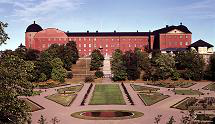Speaker
Dr
Oleg Karamyshev
(University of Liverpool)
Description
The Ultra-low energy electrostatic Storage Ring (USR) at the future Facility for Low-energy Antiproton and Ion Research (FLAIR) will provide cooled beams of antiprotons in the energy range between 300 keV down to 20 keV. Based on the original design concept developed in 2005, the USR has been completely redesigned over the past few years by the QUASAR Group. The ring structure is now based on a 'split achromat' lattice. This ensures compact ring dimensions of 10 x 10 m, whilst allowing both, in-ring experiments with gas jet targets and studies with extracted beams.
In the USR, a wide range of beam parameters shall be provided, ranging from very short pulses in the nanosecond regime to a coasting beam. In addition, a combined fast and slow extraction scheme will be featured that allows for providing external experiments with cooled beams of different time structure.
Detailed investigations into the dynamics of low energy beams, including studies into the long term beam dynamics and ion kinetics, beam life time, equilibrium momentum spread and equilibrium lateral spread during collisions with an internal target were carried out. This required the development of new simulation tools to further the understanding of beam storage with electrostatic fields.
Furthermore, studies into beam diagnostics methods for the monitoring of ultra-low energy ions at beam intensities less than 106 were carried out. This includes instrumentation for the early commissioning of the machine, as well as for later operation with antiprotons.
In this contribution, the technical design of the USR will be presented with an emphasis on the expected beam parameters available to the different experiments at FLAIR.
Primary authors
Dr
Alexander Papash
(Max Planck Institute for Nuclear Physics, Heidelberg, Germany)
Dr
Alexander Smirnov
(Max Planck Institute for Nuclear Physics, Heidelberg, Germany, Joint Institute for Nuclear Research, Dubna, Russia (on leave))
Prof.
Carsten Welsch
(Cockcroft Institute and The University of Liverpool, UK)
Dr
David Newton
(Cockcroft Institute and The University of Liverpool, UK)
Dr
Galina Karamysheva
(Max Planck Institute for Nuclear Physics, Heidelberg, Germany, Joint Institute for Nuclear Research, Dubna, Russia (on leave))
Dr
Janusz Harasimowicz
(Cockcroft Institute and The University of Liverpool, UK)
Dr
Marco Paniello
(Max Planck Institute for Nuclear Physics, Heidelberg, Germany)
Dr
Massimiliano Putignano
(Cockcroft Institute and The University of Liverpool, UK)
Dr
Michele Siggel-King
(Cockcroft Institute and The University of Liverpool, UK)
Dr
Oleg Karamyshev
(University of Liverpool)

